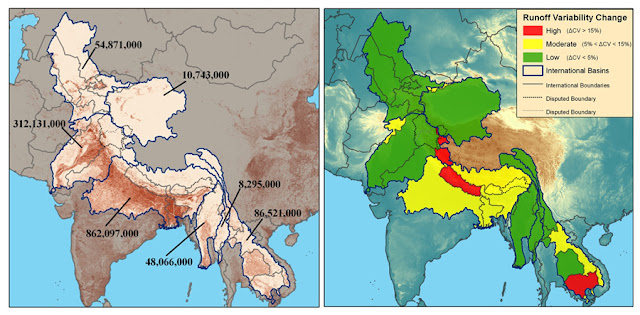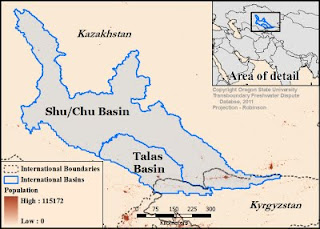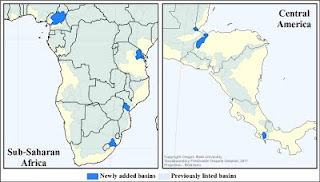-
Redrawing the Map of the World’s International River Basins
August 24, 2011 By Jim DuncanUnderstanding why conflict over water resources arises between nations begins with a solid understanding of the geography of international river basins. Where are the basins? How big are they? How many people live there? Who are the riparian nations, and what is the significance of each to the basin?
The creation of South Sudan within one of the most-watched international river basins, the Nile, recently gave the world its newest riparian nation and illustrates how quickly the geography of international waters can shift. However, other recent shifts in the hydrological landscape are the result of new data rather than new nations.
Thanks largely to improvements in digital elevation data over the last nine years, 13 new basins have been added to the Transboundary Freshwater Spatial Database, adding 501,000 km2 and an estimated 13.8 million new inhabitants to the world’s international basins, and raising the number of basins worldwide to 276. That total now includes five new basins in Central America, four in sub-Saharan Africa, two in Central Asia, and one in the South Pacific.
With this basic, accurate mapping in hand, analysts can then bring in a wider range of more interesting information to assess the geopolitical, biophysical, and socioeconomic tensions in river basins. Unfortunately, geography is subject to change, and thus accurate mapping requires constant updating.
Better Data, More Basins
The International River Basin Register, part of the Transboundary Freshwater Dispute Database hosted at Oregon State University, was last updated in 2002. Researchers using global elevation datasets and flow accumulation models delineated approximate boundaries for all watersheds that drain to the sea. Overlay digital representations of political boundaries, add in as much expert knowledge as you can, and you end up with a list of all basins that cross one or more borders. However, the results of this approach are only as good as the data you put in.
It’s possible to “miss” a basin if you can’t resolve small differences between two lines when the data are imprecise. The location of a certain contour line of elevation could be off by more than a kilometer in some places, and when propagated over long distances, the sum of these errors can result in an entire mountain valley being assigned to the wrong basin and possibly the wrong country. Because of this, the reported geography of international waters derived from this approach is open to revision.
The last two decades have seen an explosion in the quantity and quality of geographic data, including the accuracy of our political boundaries and elevation data. As the elevation data improves, so do the results of flow accumulation modeling, which leads to more precise locations of watershed boundaries. By re-doing these intersections with newer and improved data, we identified new basins that were previously invisible to geographers working with global datasets.
In some cases, these basins are relatively small or overlap only a small part of another country, but they are nonetheless international. For example, the Conventillos and El Naranja basins make up a miniscule part of the border between Nicaragua and Costa Rica, but their role in defining that border makes it hard to dismiss them altogether. More visibly, the addition of the Shu/Chu and Talas river basins, shared between Kyrgyzstan and Kazakhstan, brought 3.1 million people and 250,000 km2 of the land’s surface into “shared waters” status.
Mapping a Changing Planet
Beyond improvements in the data, the creation of new states can also alter the geography of international basins. In South Sudan, an existing basin gained a new riparian. There is also a recent example of an “internationalized” basin: With Timor Leste’s independence from Indonesia, the Loes river basin and its estimated 60,000 people transitioned into international status. Additional input from practitioners and stakeholders from around the world also helped to refine the accounting and the data as well.
Keeping up with these changes in geography goes beyond a mere technical concern when thinking about potential future shocks such as those driven by climate change. The boundaries outlining countries and river basins are very unlikely to shift in direct response to climate change. However, the impact of changes in precipitation patterns, timing, or amounts on the relative importance of a river basin to an individual country or in the relations between two countries will depend strongly on geography, and an accurate mapping of how river basins overlap nations could prove essential in assessing the importance of such shifts.
In the Himalayas, for example, mapping highlights the relationship between snowpack as a source of water in upstream countries, population density in downstream countries depending on that water, and how climate change impacts might be felt differentially based on basin-country overlaps and the relationships between states.
As we take this next step and drill down to sub-basin relationships and the geography of unique basin-country combinations, we can better see the effects of adding a new riparian, but we also face new methodological challenges from combining two datasets of differing resolutions. Add in disagreements about where the official international boundary even goes, and you find more uncertainty.
By facing these hurdles, we can only improve our spatial understanding of sub-basin relationships and our ability to assess risks and opportunities in basin management. So is this list final? The answer has to be no, as the data could be better, and the future map of the world’s nations could change substantially. But the challenge of keeping up with new data and changing geopolitics is an opportunity to continually improve our knowledge about international basins and the way we represent their geography.
And now, the complete list of newly added basins:
- Chamelecon (Guatemala, Honduras)
- Conventillos (Costa Rica, Nicaragua)
- Corredores/Colorado (Costa Rica, Panama)
- El Naranjo (Costa Rica, Nicaragua)
- Loes (Indonesia, Timor Leste)
- Moho (Belize, Guatemala)
- Pangani (Kenya, Tanzania)
- Pungwe (Mozambique, Zimbabwe)
- Sanaga (Central African Republic, Nigeria, Cameroon)
- Shu/Chu (Kazakhstan, Kyrgyzstan)
- Talas (Kazakhstan, Kyrgyzstan)
- Temash (Belize, Guatemala)
- Thukela (Lesotho, South Africa)
Jim Duncan is a consultant for the World Bank Institute where he is developing an interactive mapping application to provide tools citizens and policymakers can use to demand greater transparency and accountability in the extractive industries. He spoke at the recent Wilson Center event, “International River Basins: Mapping Institutional Resilience to Climate Change.”
Maps Credit: Used with permission, courtesy of the Transboundary Freshwater Dispute Database, Oregon State University.
 A Publication of the Stimson Center.
A Publication of the Stimson Center.






